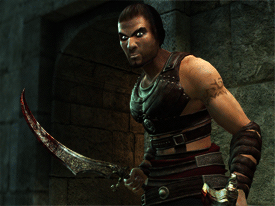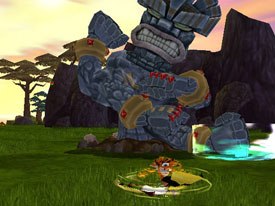Karen Raugust talks with smaller animation studios who are creating cinematics and, increasingly, in-game assets for video and computer games.

A number of smaller studios are creating animation for publishers and developers of videogames, including for the console, PC and online platforms. In many cases, their work is limited to cinematics/cut scenes and promotional trailers. But there is more and more demand for in-game assets as well.
There have long been studios specializing in this market. Companies like ours have been around a long time, says Krissie Franco, vp production at Hydrogen Whiskey Studios, which has been in business since 1991. It has been creating gaming animation for 12 years, and doing so almost exclusively for the last 10, worked on franchises such as Civilization and WWE.
General animation companies are starting to get more heavily involved in game animation as well. Perky Pickle Studios, which launched in 2000, is one example. It creates animation, from preproduction through post-production, for all platforms and in all styles. Perky Pickle has worked on Vivendi Universals Crash Bandicoot franchise, and was involved creatively during the entire development process, according to owner Jordan Reichek. There are incredible possibilities for us in animation to be branching out, he says.
The more lines you have in the water, the more bites youll get, agrees Floyd Bishop, founder of Bishop Animation in Honesdale, Pennsylvania. His company has been in business since April 2005, and has worked on seven games for the PlayStation Portable and PlayStation 3 in the last year, including cut scenes for Untold Legends. Meanwhile, it has been busy on other projects, too, such as the hair and fur simulations for Nickelodeon/Paramounts film The Barnyard.
Similarly, Realtime UK, a studio with 24 full-time employees, creates animation for games, including several titles in the Buzz! franchise for Sony Computer Entertainment Europe. Meanwhile, it also takes on TV animation, architectural animation and automotive and defense projects, according to managing director Tony Prosser.
Cinematic Convergence
Historically, game developers and publishers have gone to outside animation studios primarily for cut scenes/cinematics and for trailers, which are used to tease the games at industry events like E3. That still represents a large percentage of the outsourced animation work in the gaming industry. But increasingly, animation studios are also being asked to create assets used in game play. Bishop Animation, for example, has created models and rigs for a PSP title.
Franco reports that Hydrogen Whiskey has been doing in-game assets for the last five years, starting with the previous next generation of console games. It currently sees its work split about 50/50 between in-game assets and cinematics. The company is tackling three projects, one a high-res trailer for E3, one an in-game cut scene, and another involving the creation of pieces for gameplay namely, shirts, pants and hair gamers can use to create their characters.
Cinematics and in-game assets are converging to a degree. Cut scenes often run on the games realtime engine, for example, and in-game assets are used to create the cinematics. The latter results in the characters looking virtually the same in the animations as they do during game play.
Beyond Consoles
Much of the demand for outside animation services comes from the console segment, where next-generation games, in particular, feature huge amounts of data. But animation studios are also working on games for other platforms, including PCs, online and mobile.
Creative Capers Ent., for example, creates both animation and in-game assets for PC and online gaming projects including Bounty Hunter, a number of Disney edutainment titles, and animated emoticons and casual downloadable games for AOL, according to creative director David Molina. The company is a full-service animation house that works on direct-to-video projects and features, in addition to games.
Left Brain Games produces sponsored online games for clients such as Wonka.com, Van Gogh Vodka and Weird Al Yankovich. According to president Andrew Keplinger, the companys talent includes animator Dave Lovelace, known for his property Retarded Animal Babies, which has an online following. Left Brain is also considering making games for other platforms, including mobile phones and iPods.
Keplinger explains that the amount of Flash animation varies by sponsor in the kind of casual online game typical of advergaming. It depends on where their budget is, he says. Animation is usually one of a menu of add-ons that are over and above the baseline cost of the game. Still, the average online game is relatively inexpensive. You can develop 10 online games for what it costs to develop one cell phone game, Keplinger reports.
Next-Generation Growth Prospects
On the console side, the new generation of games including the Xbox 360 and PlayStation 3 should spur a greater need for publishers and developers to hire outside animation companies. The production cycle on games is about a year now, Bishop points out. The cycle is so short, and the amount of assets is so huge. In addition, the sheer number of videogames released in a year exponentially more than films, videos or TV shows adds to the pressure.

The Xbox 360 and PS3 also show more detail than previous-generation games, using high-res models, textures, lighting and animation. Its all on a grander scale, says Mohammed Davoudian, president/ceo/creative director at Brain Zoo Studios, a 10-year-old house that makes 3D animation for films, visual effects, music videos and commercials, as well as game cinematics for franchises such as Prince of Persia and Civilization. He notes that game developers dont have as much experience with very high-res images as 3D animation studios do, at least not yet.
In order for games to get better and better, which is being demanded, game companies realize they have to hire professionals for certain parts, Franco says. She notes that the industry has matured in the last decade or more since Hydrogen Whiskey has been in it. Its not all fun and games anymore.
Franco points out that her studio is typically responsible for all aspects of the projects it is assigned, including hiring actors and mo-cap stunt men, and working with sound and voiceover studios. Most game companies have an established process for working with animators these days, a situation that is much different from 10 years ago, when an animation house had a hard time opening doors. They treated me like I was trying to sell car insurance, Franco remembers. Now theres a person in charge of it.
International Outsourcing
As in all sectors of animation, some game publishers and developers are looking to cut costsbudgets typically are lower in gaming than in other types of animationby outsourcing 3D work to companies abroad. Studios such as Asiadigita in The Philippines, Plastic Wax in Sydney, Australia, and Picturebox Animation Studios in Thailand are among those that carry out animation projects for the gaming industry.
But U.S.-based animation studios, especially those with small full-time employee rosters, say they can compete on such jobs. We cant compete with them on price, but they cant compete with the communications and quality that we have, Franco says. She notes that while Hydrogen Whiskey hasnt been negatively affected by outsourcing in terms of its total workload, it has lost bids for individual jobs to overseas studios.
Studios that can do the work domestically and with a small staff are attractive to game developers and publishers, who are trying to maintain secrecy about the games theyre releasing in this competitive market. And, with their low overheads, some smaller U.S. studios can even close the price differential. [Publishers and developers] can get quality work here at a lower budget than they might think, Bishop says. Our cost in Honesville, Pennsylvania, is ridiculously low.

Creative Input
While the process of creating animation for videogames is similar to that of working on 3D television or film, projects are faster-paced, with a high degree of quality demanded, as well as a very fast turnaround, all for relatively low fees.
There are other differences between gaming and entertainment. Often, for example, gaming animation is only a few frames long. In features or commercials, you get the viewer to interact with and accept the character, says Davoudian. In a game, on the other hand, You do a happy cycle, a walk cycle, a run cycle, a death cycle. Youre just moving the character around.
Frame management is the name of the game, explains Molina. Youre really thinking about every frame.
[Animators] think about the big picture, Reichek says. [Game developers] think about minutiae. In general, he says, game developers pick out pieces of the animators work to incorporate into a game, not seeing the work as a whole story but rather as chunks of action.
Still, the trend is for more story to be included in each game, and animators can help. Reichek notes that the script he wrote for Crash Bandicoot: Twinsanity, was almost 1,000 pages, with a huge amount of dialogue and sound effects, as well as animation clips. In an ideal world, I was looking for a cartoon you can play. It can be done, with all the nuances you have in a character, but it becomes something you control.
You can have a better story, and get the characters to emote instead of just run, jump, shoot, says Davoudian, who believes games will feature more subtleties, such as greater facial expression that enhances character and story, as time goes on. Noting that Brain Zoo recently added a vfx producer from Stan Winston Productions, André Bustanoby, Davoudian says, We want to give more of the sensibility of feature films to games, in the cinematics and beyond.
Both [films and games] are about story, Molina explains. But the two have different types of story vehicles. Our experience in feature film has helped us a lot because we understand story, and we can infuse that into the game.
Franco believes the amount of creative input demanded from an animation house by game publishers and developers has increased significantly over the last decade. Weve become more of a production house instead of an animation house, she says.
Karen Raugust is a Minneapolis-based freelance business writer specializing in animation, publishing, licensing and art. She is the author of The Licensing Business Handbook (EPM Communications).








